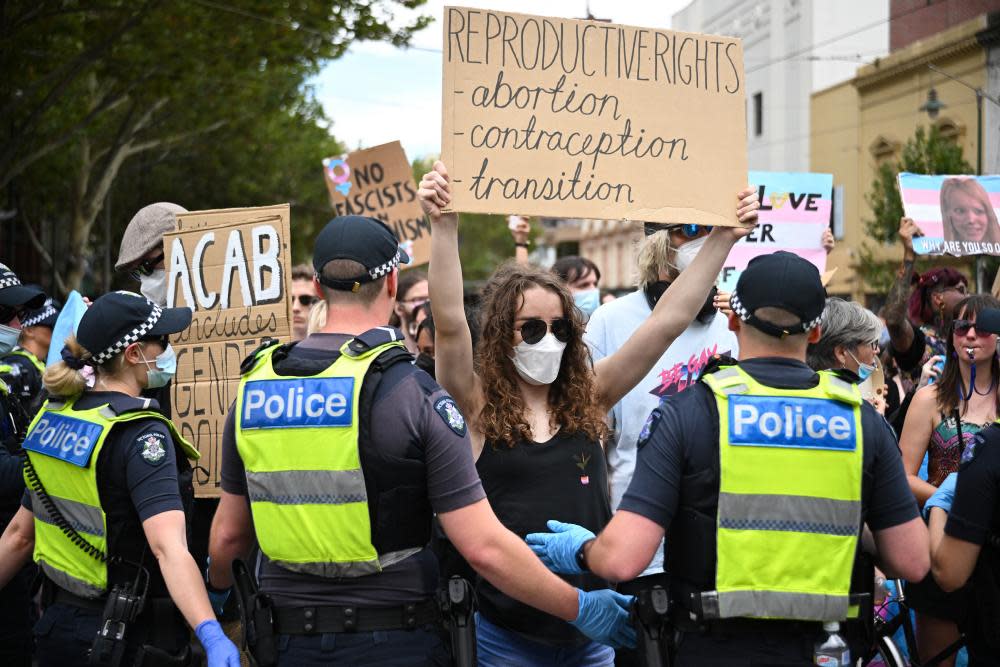Victoria can deny Nazis a breeding ground with deradicalisation instead of playing whack-a-mole with bans

Victorian premier Daniel Andrews’ announcement about legislation to ban any public displays of the Nazi salute may seem like swift and decisive action, like the recent ban on the public display of swastikas, but such legislation is likely to do little to stop violent extremists, and could even hurt those it is supposed to help.
Criminalising a symbol or action, even one as odious as the Nazi salute, is extremely tricky and almost impossible to enforce. Groups can easily get around such bans by changing their symbols or gestures to avoid breaking the law. This happens online all the time.
Sign up for Guardian Australia’s free morning and afternoon email newsletters for your daily news roundup
Groups have developed new words to get around content moderation, while anti-vaccine groups started calling themselves “dance parties” to get around social media bans. Bans create a whack-a-mole situation where we are consistently looking for new symbols/gestures associated with the groups to try to outlaw.
It’s not just that these bans are ineffective however, it’s that they can often backfire.
Legislation such as this is often used as recruitment fodder for far-right groups, giving them something to point to as another example of government overreach and authoritarianism. This may be enough to tip some people sitting on the fence into the camp of these organisations.
Related: We need to talk about extremism and its links to Christian fundamentalism | Josh Roose
More worryingly, it can also end up harming innocent parties, particularly if it does not take intent into account. Victoria’s swastika ban, for example, bans the display of the Nazi symbol in a public place if someone knows (or ought reasonably to know) that it is associated with Nazi ideology.
There are defences available for this offence including genuine academic, artistic, religious, scientific, educational or cultural purposes. It’s unclear, however, how these defences will apply to political protests. The act allows for the display of the Nazi symbol “to signal opposition to nazism” or on a sign which “contains words stating opposition to fascism”. However, what if protesters wished to use Nazi imagery to compare Australia’s migration policies or robodebt failures to fascism? It’s unclear whether any defence would be available.
It is for this reason that many organisations are sceptical of such bans, and of vilification legislation in general.
In a submission on changes to hate-speech legislation in New South Wales in 2018, for example, the Aboriginal Legal Service raised a fear of the “racial vilification offence potentially being used by police against Aboriginal people when, under certain circumstances and in the heat of the moment, racially charged language is directed at police officers.”
The same could be said for this bill to ban Nazi salutes. What, if in the heat of the moment, a protester uses the Nazi salute to a police officer to point out their potential Nazi sympathies? Legislation would not distinguish between these events, meaning someone protesting Nazis could easily end up in jail.
That doesn’t mean the government shouldn’t be doing anything. If we want to stop Nazis marching on our streets, there are a range of long-term things we can be doing that don’t rely on banning everything to do with the movement.
First is to delegitimise leaders of these movements and their ideas, not through arguing or debating with them, but instead by showing they are a minority force. This means not giving them a platform in the media and working hard to undermine their legitimacy through, for example, treating their ideas and arguments as irrelevant to a modern society.
Social movements in the US have also been extremely successful in undermining far-right movements by simply showing up, consistently showing that extremists are a minority and that progressive views can and will win. Such campaigns have left many far-right leaders with dwindling platforms, removing any capacity for them to gain a follower base.
In addition, we should also aim to get as many “followers” out of the movement as possible.
Around the world, governments and community groups have done so through deradicalisation organisations, which work on the ground to get members out of the far right. These groups do not seek to punish individuals, but instead work one by one to get individuals out by focusing on the root social causes of why some people become attracted to extremist groups, and then finding them a different path to take.
The deradicalisation can often be slow, but it is a process that can be fruitful if followed closely. While it will not get everyone out, groups such as this can often be successful enough to undermine an extremist organisation’s base to the point where they are no longer viable.
While legislation to ban the Nazi salute will be a symbol from the government that it is doing something, it will really achieve very little. Instead, it has the potential to be used against the very people it is supposed to protect.
What we really need is long-term solutions that undermine these movements. That means dealing with the root causes of why these groups exist in the first place and giving people a different path to head down instead.
Simon Copland is a PhD candidate in sociology at the Australian National University, studying online men’s rights groups and “manosphere” communities. He is a member of the Greens

 Yahoo News
Yahoo News 
